 [A
radical meta-art system shooter] -
[A
radical meta-art system shooter] -  [Narratives
of the code]
[Narratives
of the code]nybble-engine-toolZ
- http://www.climax.at,
Margarete Jahrmann / Max Moswitzer 2003
[nybble-engine-toolZ
home] -  [A
radical meta-art system shooter] -
[A
radical meta-art system shooter] -  [Narratives
of the code]
[Narratives
of the code]
The
network game and installation *nybble-engine-toolZ*is an
example for a
mediapoietic work.
*nybble-engine-toolZ*
- A radical meta-art system shooter and practical model of mediapoiesis
The
project *nybble engine toolZ* re-engineers such an existing
commercial system
as a game engine sprinkled with network commands. A nybble
is the
unit of half a byte or four bits and thus the basis of every digital
conversion. As the numeric equivalent of the binary code, it
exemplifies
the internal logic of a software, that converts codes and protocols on
a server
into various representations.
*nybble-engine-toolZ*
- as a radical
meta-art shooter,
serves as a self-ironic multi-player statement tool. The network
suggested for
the interactive installation consists of players on site in the
installation,
actors on a remote site in the city and spectators connected to the
running
nybble-engine game server via the Internet. When shifting between
these
positions participants become <spect-actors>, active
spectators,
changing between the interactive and the interpassive role of a
player with
code and a writer of code, between a visitor in an installation and
an
actor in a virtual environment. E-mails can be sent into the
nybble-game
environment and change it. There are also outgoing mails to
president@whitehouse.gov. We applied the newly coded game-features,
as out
and ingoing mails, sensible from a <cyber-Nethical> point of
view. The
scientist and philosopher Heinz von Foerster introduced the term KybernEthik,
(Foerster, Berlin 1993). He is talking about a second order ethics,
according
to a second order cybernetics, which is following the observation of
the
observation as principle. In intended contrast to the violent
aesthetics of
the computer game, the project is based on anti-war e-mails,
commissioned
with each shot made with the game pad in the installation and the
online
network. So the toolz are usefull for the lessons in self defense,
which
the citicens of contemporary democratic societies should take to be
able to
resist against manipulation and control, as Noam Chomsky described
it (New
York 2002).
Each
toolz-email is displayed in real-time as both ASCII text and newly
generated
visual object. Out of this visually coded environment, text
messages are
sent. This can also be commands from the running engine itself to the
network.
E-mails inside the engine trigger the environment of action-bots
(these
are software player-robots with a minimal artificial
intelligence),
although one can also directly log in on the game-server. While moving
through
the environment, trace routes are started from the game to a
number of
crucial government servers. Network activities outside the
engine are
displayed in the game environment in real-time as texts and 3-D
objects.
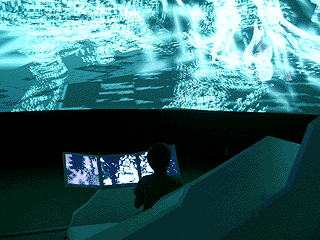
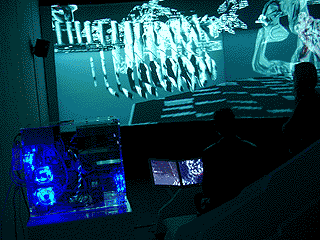
click on the image for a
large view
The installation: an interactive/interpassive group experiment
The architecture of the installation room, where the participants are able to take seat, is shaped like the 3-D form of the virtual environment. This form is a trace of the movements inside the network environment. We transfer this data-form into the installation room, by making a 3D printout in real size of the virtual object. Following contemporary architect and theorist Bernard Cache’s example, we call these forms objectiles. In reference to Bernard Cache, Gilles Deleuze defines an ‘objectile’ as “a very modern conception of the technological object” 3. Inside the virtual space each actionbot or player’s avatar carries a data object instead of a weapon. As these objects represent command lines and processes from the game environment, they also appear as a part of the installation interface, as laser-sintered <objectile>. In its pure form as code equivalent and as discourse object it is exhibited as a code hardcopy.
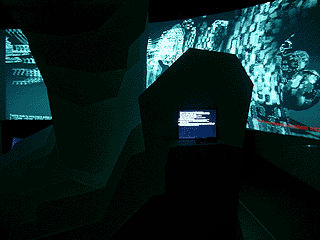
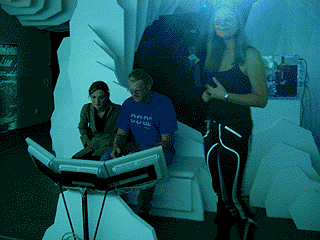
click on the image
for a large view
The
peer-to-peer software of the installation converts network processes
into
three-dimensional abstract movies and projects these onto a 180-degree
screen, such as experienced in an interpassive cinematic situation.
The
network codes and commands are generated with the aid of game engines
into
audio-visual so called machinima movies. Simultaneously
they are
playable command lines in the networked game environment.
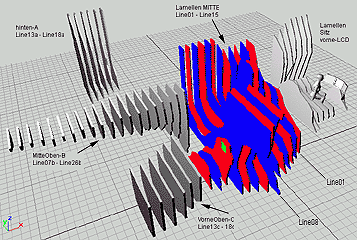
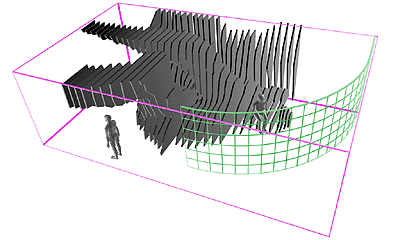
The
participants in the experiment can, however, also become active in the
installation space. At a small control desk they see their
individual
view of the navigation, which presents a subjective perspective at
variance
with the server view on the screen. The players use an ordinary
game pad to
log onto the network of the installation and to enter into the shooter
environment, where projectiles of data object(ile)s, action bots as
well as
other players are flying about. Each time a data object is hit,
network
processes are triggered, each time a shot is fired with the game-pad,
an
anti-war email is sent. There are two choices for the spectator: either
to
become a player who concentrates on the small Gameboy monitor and
successfully
navigates and influences what is happening on the big screen, or to be
the one
whose attention fluctuates and combines the different perspectives –
those of
man on the small screen and those of the server-machine on the big
surround
screen. If one concentrates on the personal view, it influences the
entire
picture being simultaneously generated and projected. Seeing this
simultaneous
view of one running application in different windows might motivate
viewers to
intervene in the communication. In the case that no one is taking part
in the
installation space the action bots and online players take control over
the
action.
nybble-engine-toolZ
was developed in cooperation with the V2_lab Rotterdam and a first
version was
installed at the exhibition "Metadata", at the Dutch Electronic Arts
Festival 03 in February 2003.
“Billing
itself as a "radical meta-art system shooter" and "collaborative
statement tool," Margarete Jahrmann and Max Moswitzer's nybble-engine-toolZ
explores very different forms of interaction to the other two winners.
The
project may be more of a deliberately abstruse experiment than
a
transparent implementation of a tool – it doesn't conceal its self-ironic
attitude – but investigates important aspects of networked,
open systems
and real-time programming tools. Referring to the nybble (half
a byte,
or four bits) as a basis of digital conversion and software
logic, nybble-engine-toolZ
is a peer-to-peer server network and modification of the Unreal game
engine
that self-reflexively constructs the game itself out of network
processes.
Players may log on to the engine from various locations –
including the
installation, a 180 degree circular screen – to navigate the
environment, meet
other players and bots (in this case, representations of server
processes)
and communicate with them. Shots fired in the environment generate
anti-war
mails or calls for peace to a government server; pressing
buttons on
the gamepad sends ping commands to government servers. The log
files
produced by the network traffic itself and data on the hard disk
(text,
images and sound) become raw material for 3D "movies" out of
which the game environment itself is constructed. The environment
thus consists of real-time network activities. As a conceptual
proposal,
nybble-engine-toolZ raises important issues about generative
art, the
possibilities of software and engines as tools. Game engines are
arguably
one of the most important (and underexplored) generators of narrative
in the
broadest sense. Jahrmann / Moswitzer's project opens up the engine
– as a
tool and algorithmic framework for handling the "mechanics" of
game playing – and makes it reflective of the process of playing
itself. nybble-engine-toolZ
points to the possibilities of game playing as editing of code and
rewriting of
the very tool that creates the game in an open collaborative system.
The
re-engineering of existing, commercial systems (such as game engines)
or
their inversion and subversion has also increased, although this
territory
arguably remains under-explored. Considering the potential of the
digital
medium, there are still relatively few works that create open
systems by
allowing users a sophisticated reconfiguration or rewriting of the
system
itself or by relying on networked communication processes
in
challenging ways.”
(Prix
Ars 03, Interactive Arts, jury statement, http://www.aec.at/en/prix/updates/article2.asp?iNewsID=309&iFollowUpID=1051
[nybble-engine-toolZ
home] -  [A
radical meta-art system shooter] -
[A
radical meta-art system shooter] -  [Narratives
of the code]
[Narratives
of the code]